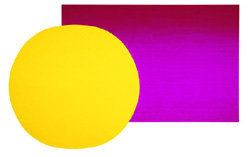Rupprecht Geiger
dal 17/7/2008 al 4/10/2008
Segnalato da
17/7/2008
Rupprecht Geiger
Neue Nationalgalerie, Berlin
Centenary

On the 26 January this year, the Munich-based artist Rupprecht Geiger celebrated his 100th birthday - giving the National Gallery the perfect opportunity to pay tribute to him with an exhibition of selected works. A collection of early works from the late 1940s and 1950s will be on display in the graphic room at the New National Gallery, among them a selection of shaped canvases which show how Geiger broke free from the rectangular picture format well before his counterparts in the USA did.
A central characteristic of Rupprecht's art is his choice of radiant colours, applied over the entire surface and contained in clear geometric forms. Colour, form and light take on a central significance in these colour field paintings. Over the course of his career, they have become increasingly more monochromatic in composition - with the colour red now having played a dominant role since the start of the 1970s. Rupprecht's experiences as an architect clearly helped inspire his large scale paintings and, in the process of applying the paint or spray paint, also allowed him to combine something of the space itself into the surface of the canvas.
In the upper hall at the New National Gallery a number of such large scale works will be on display. In these, the colours seem to vibrate with an almost magical intensity, absorbing the space around them. The Rote Trombe or ‘red whirlwind', a kind of marquee of colour, which was first exhibited in Berlin at the Akademie der Künste in 1985, as well as the two eight-meter-high flags Abend Rot and Morgen Rot from 2000 and the four-part installation created for the XXV Biennale in Sao Paulo in 2001, will all be given a new lease of life in the wide open space of Mies van der Rohe's glass hall.
Neue Nationalgalerie
Potsdamer Strasse 50 - Berlin



